Greatest Hits: Oscar De La Hoya
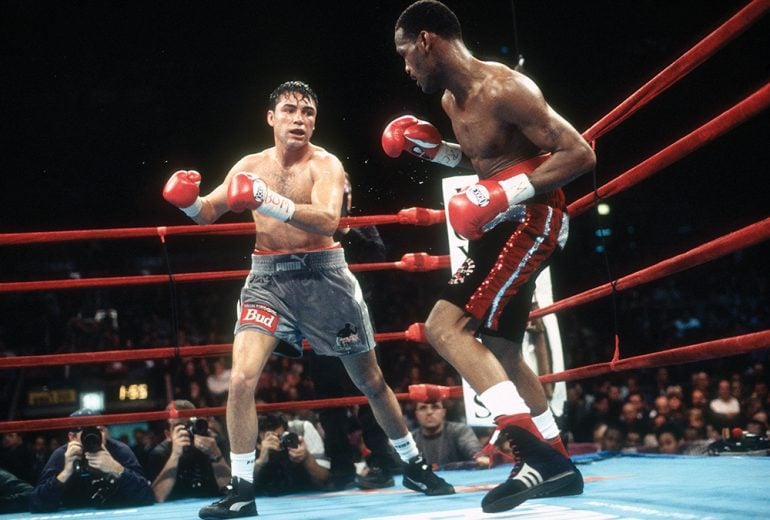
Editor’s Note: This feature originally appeared in the Oscar De La Hoya Special Issue, which is available for purchase at The Ring Shop.
LOOKING BACK ON HIS INCREDIBLE PATH FROM OLYMPIC CHAMPION TO BOXING ICON, THE GOLDEN BOY REVISITS SIX CAREER-DEFINING FIGHTS
Oscar De La Hoya was born in East Los Angeles on February 4, 1973. His beginnings were particularly humble.
“I grew up in East L.A. surrounded by drugs and gangs,” De La Hoya told The Ring. “It was tough, but luckily I had boxing to keep me away from all of that. Boxing gave me everything I have today. I owe everything to boxing.”
His grandfather boxed as an amateur, then his father boxed professionally. Oscar followed in their footsteps and began his own journey at age 6.
De La Hoya thrived as an amateur and won a slew of national titles to book a place on the U.S. Olympic team at the 1992 Barcelona Games. There, his victory in the midst of grieving for his mother captivated viewers.
“Boxing gave me everything I have today. I owe everything to boxing.”
“The Olympics are a worldwide stage that catapulted me to superstardom,” De La Hoya said. “The gold medal to me will always be the biggest accomplishment that I’ve ever captured in my boxing career. I won world titles in six different weight classes, but the gold medal by far will be my biggest accomplishment inside the ring.”
After making his pro debut with a first-round knockout in November 1992, De La Hoya was extremely active, fighting 11 times through the first 16 months of his new career. He regularly showcased his talents on prime undercard spots and gained the requisite experience before landing a fight with Jimmi Bredahl for the relatively new WBO junior lightweight title. De La Hoya claimed the first of his many belts by 10th-round stoppage in March 1994.
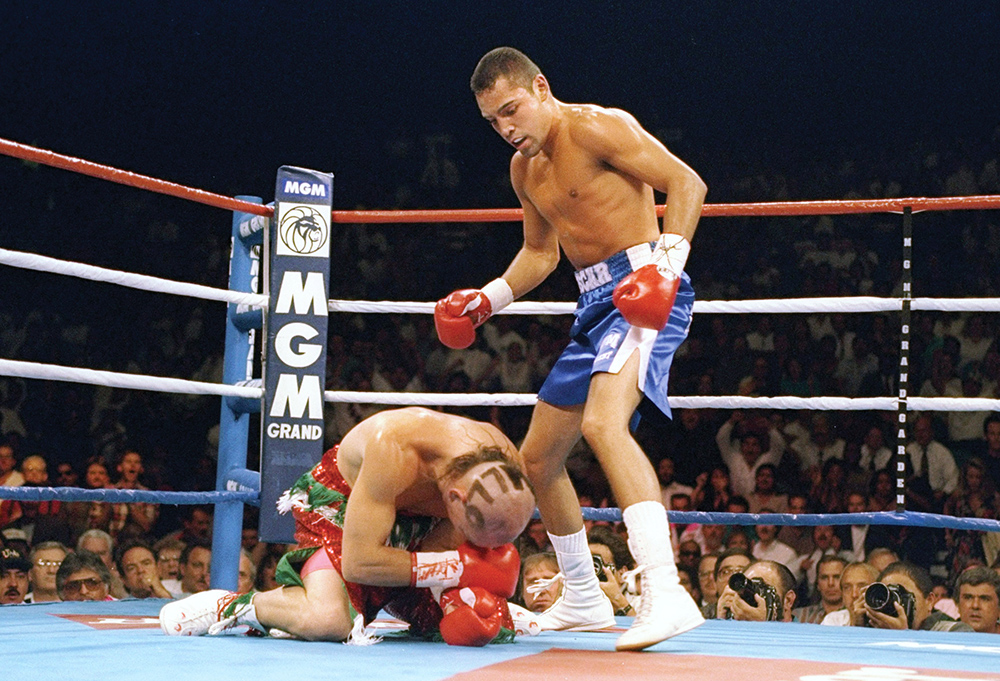
De La Hoya picked up his second world title at the expense of Jorge Paez.
“The Golden Boy” wasn’t without his detractors, who questioned if he had the substance to go with his matinee idol looks and charisma. They pointed to the ignominy of a trip to the canvas against unbeaten but unheralded Giorgio Campanella, whom De La Hoya stopped in three rounds in his first title defense. Those critics would dwindle in number as De La Hoya moved up to lightweight, where he collected the vacant WBO title against Jorge Paez (KO 2) in July 1994 and then staged a series of four high-profile victories in 1995.
Junior welterweight and a clash with boyhood hero Julio Cesar Chavez was next, giving De La Hoya the opportunity to take down a living legend. The success continued at welterweight, starting with Pernell Whitaker in April 1997 and extending through seven defenses against the likes of Hector Camacho and Ike Quartey.
His popularity was very much in evidence during this stretch when over 40,000 fans came to the Sun Bowl in El Paso to watch him thrash unknown mandatory challenger Patrick Charpentier in three rounds.
“Oscar was ability and marketability personified, a rock star wherever he fought in those days, but he never fought in Mexico,” said Bruce Trampler, who was the matchmaker for De La Hoya during his time at Top Rank. “The closest he came was El Paso, right on the border across the Rio Grande from Juarez, and his fans responded with a huge advance ticket sale. If we had another 10,000 seats to sell, they would have been gone as well.”
It all helped build up a superfight with longtime IBF ruler Felix Trinidad, but “Tito” would finally bring The Golden Boy’s winning streak to an end.
More iconic fights would follow. The SoCal showdown with Shane Mosley. The bitter grudge match with Fernando Vargas.
After De La Hoya lost his titles to Mosley in their rematch, he decided to step up to middleweight. He edged past Felix Sturm (UD 12) in controversial fashion to claim the WBO title in his first fight at the weight.

De La Hoya poses with his bronze likeness outside Staples Center (now the Crypto.com Arena) in Los Angeles. (Photo by Amy Sussman/Getty Images)
That set up a fight with Bernard Hopkins in 2004 to crown the undisputed middleweight champion. Early on, De La Hoya’s sharpness and speed gave Hopkins trouble in a tactical battle. However, Hopkins broke through and landed a debilitating left hook to the body that stopped De La Hoya in Round 9.
In the twilight of his career, De La Hoya lost to boxing superstars Floyd Mayweather Jr. (SD 12) and Manny Pacquiao (TKO 8) before retiring with a record of 39-6 (30 KOs).
Looking back, De La Hoya is particularly proud of the statue of himself that stands outside the Crypto.com Arena (formerly Staples Center).
“We were able to be honored with a statue outside the Crypto.com Arena to commemorate my long-lasting career here in Los Angeles,” he said. “The fact we were the first ones to stage an event at the arena was very special. It’s not bad company (the statue is beside others of sporting superstars Magic Johnson and Wayne Gretzky) and it goes to show you that L.A. is very rich in sports and they appreciate their sports heroes. So it’s a pretty nice feeling to have that statue.”
Since retiring in 2008, De La Hoya has battled personal demons. He hopes he can put them behind him.
“Just to be at peace with myself – that’s my goal,” said the 2014 International Boxing Hall of Fame inductee. “To leave a legacy outside the ring that I’m happy, that I’m satisfied with, and that’s the relationship with myself.”
De La Hoya, now 49, is a father to six children and lives in Los Angeles, where the company he founded, Golden Boy Promotions, is based.
However, it is his work away from sports in the local community that he feels is most worthwhile.
“My foundation is my baby; we helped build several cancer centers in East Los Angeles,” he said. “Through my foundation, I built a high school for kids called the Oscar De La Hoya High School, which is one of the more successful high schools in the greater Los Angeles area for inner-city kids.
“It’s been a wonderful ride. I’ve been able to do a lot of great things for a lot of people. It’s been a lot of fun and it’s not over yet.”
De La Hoya looked back on his career and reminisced about six career-defining performances for the readers of The Ring:
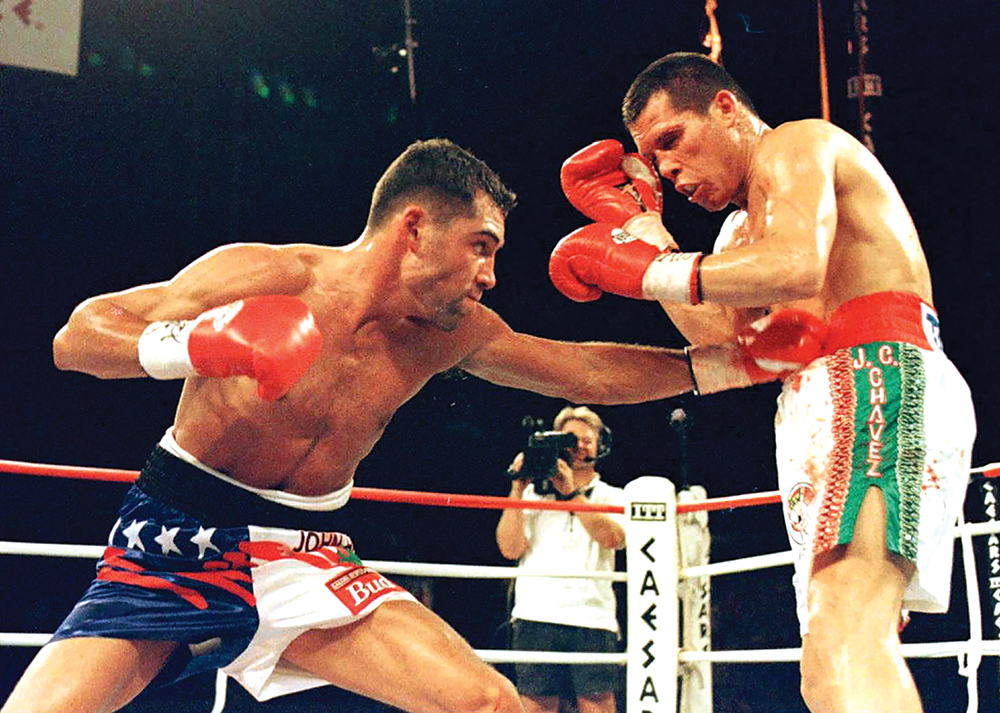
Chavez fans were shocked to see their man on the defensive. (Photo by John Gurzinski/AFP via Getty Images)
JULIO CESAR CHAVEZ
June 7, 1996, Caesars Palace, Las Vegas • Title: WBC junior welterweight
“We sparred when I was 14 years old. He was getting ready for Meldrick Taylor. It was the last week of his preparation and he wanted to just loosen up and focus on losing the weight. He wanted three small guys to help him with speed, so they called me, Sugar Shane Mosley and another friend of ours, Pepe Reilly. That was the very first time [I met Chavez].
“The reason [our fight] was so impactful on my career is because it was the first time that fans were criticizing me, that fans were against me, going up against a Mexican legend like Julio. It was different for my career and what I was so used to.
“Plus, everything that happened around the fight with the Mexican government, the Mexican cartel. What happened was he was training in Culiacan, Mexico, and I was training in Big Bear, California, and I was getting threats almost every day. I was getting threats from the government saying if I beat Julio, I could never go into Mexico again. A lot of distractions – tons and tons of distractions.
“I remember getting inside the ring and looking at Julio Cesar Chavez across the ring and telling myself, ‘Oh my gosh, that’s my hero.’ It could have been very distracting, but I was able to hold it together and stick to my game plan. [The experience of sparring Chavez] helped me stay away from his right hand. He hit me with a right hand that almost put me to my knee. I cut him early with a left jab, but my boxing ability that night [was on point]. Nobody could beat me that night.
“It solidified me as a top, top fighter. I was fighting very often, so I had one week off and I had to go back to the mountain to train. I was with family and friends and right back to business.”
Result: De La Hoya TKO 4

De La Hoya came back strong in the championship rounds. (Photo by JOHN GURZINSKI / AFP) (Photo by JOHN GURZINSKI/AFP via Getty Images)
IKE QUARTEY
February 13, 1999, Thomas & Mack Center, Las Vegas • Title: WBC welterweight
“Nobody wanted to fight Ike Quartey, nobody knew him, so I volunteered.
“Three weeks before [the original November 1998 fight date], I got cut in sparring, so I had to take two weeks off. I went into the [rescheduled] fight thinking it was going to be easy. At that time, I was unstoppable at welterweight. I would have to say it was the toughest fight of my career.
“Ike Quartey hit like a sledgehammer and had a beautiful jab. That sixth round [we both went down] was incredible, but the 12th round was amazing. What was very impressive was his chin. The last round when he was on the ropes, I couldn’t believe how he was still standing up. I must have hit him with 25 punches unanswered and I couldn’t believe the referee didn’t stop the fight. That was a classic.
“I took an Uber yesterday and the driver was from Ghana. He was so excited, and I asked him about Ike Quartey and he told me that Ike Quartey is doing very well. He’s happily retired. He’s building a hospital in Ghana. I’m very happy for him.”
Result: De La Hoya SD 12
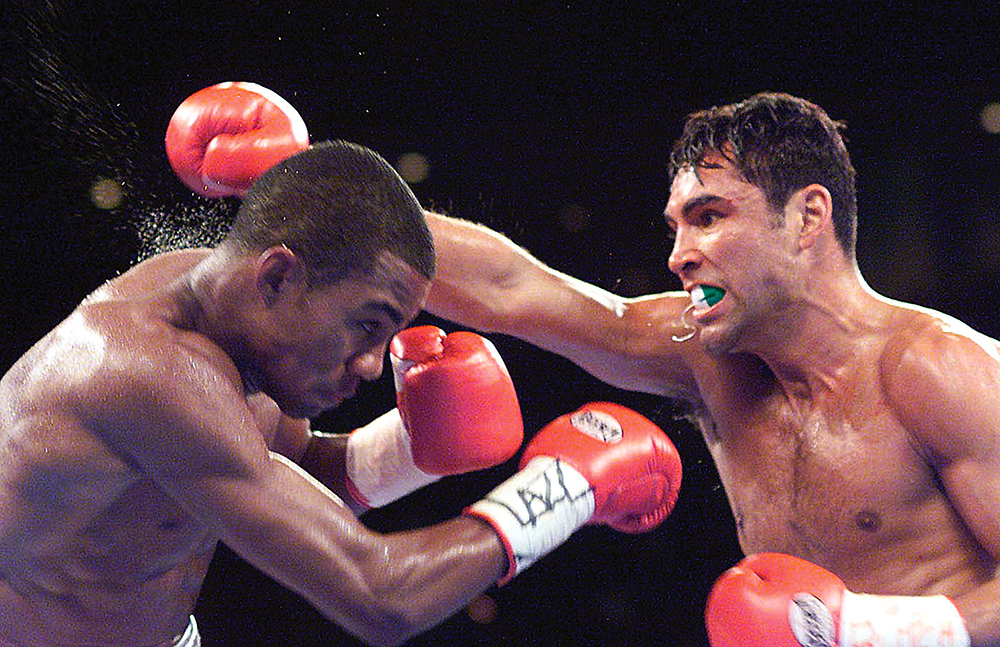
Head-to-head with Tito. Photo by Gary M. Williams/Liaison
FELIX TRINIDAD
September 18, 1999, Mandalay Bay, Las Vegas • Titles: IBF/WBC welterweight
“I had the late, great Gil Clancy in my corner and we trained for three months up in Big Bear, and every single day Gil Clancy would remind me, ‘You have to box Trinidad. Box him, box him, box him. Do not let him hit you, because he hits hard.’ So for three whole months, we trained to box Trinidad.
“Two weeks before the fight, the last day I was in Big Bear, we’re doing our normal running routine in the morning, we’re running the mountain and as we’re running down, I twist my ankle. I rolled my ankle. It was bad; it ballooned up like a tennis ball. So I couldn’t spar anymore, I couldn’t run anymore. I could maybe shadowbox. So when we got to the fight, I had to wrap my ankle with duct tape.
“I’m boxing him, I’m winning the fight. It’s a fairly easy fight, the first nine rounds. The last three rounds, Gil Clancy starts yelling at me, telling me, ‘Box the last three rounds, get on your bicycle and box the last three rounds.’ So I did and got the fight stolen away from me. I was more disappointed in myself that I didn’t listen to my instinct. Normally I close the show, and I listened to Gil Clancy, and Don King was able to take away the fight from me. It made me think I have to always go with my instinct and always go for the kill. There were talks of a rematch, but Don King didn’t want to.”
Result: Trinidad MD 12
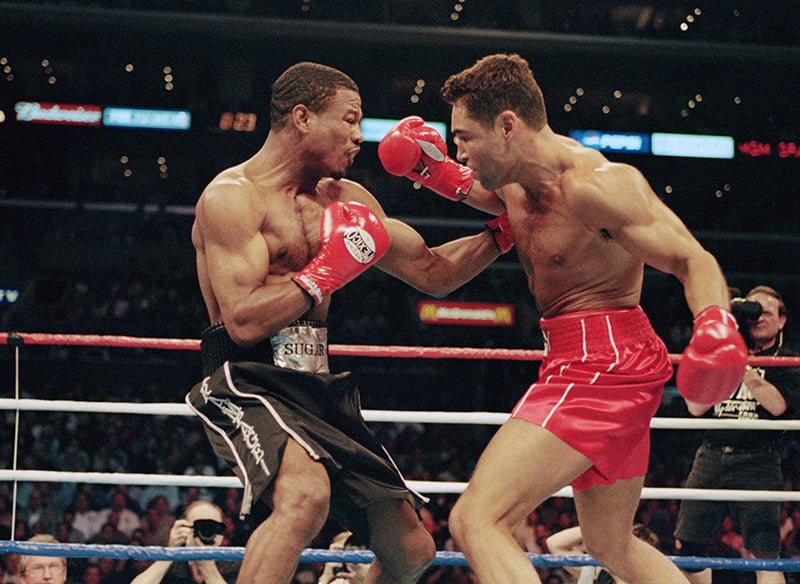
Mosley and Oscar De La Hoya let it all hang out during the final round. Photo by Al Bello-Getty Images
SHANE MOSLEY
June 17, 2000, Staples Center, Los Angeles • Title: WBC welterweight
“Me and Shane went back since we were 9, 10 years old. We fought one time [as amateurs] – I believe he beat me. I’d always knew Shane Mosley was a very difficult and dangerous fighter that nobody wanted to fight at the time. What made it special was opening up the Staples Center, now known as the Crypto.com Arena. The event was bigger than the [Academy Awards]. Everybody was there – you name it. It was star-studded and the fight lived up to its expectations.
“I knew it was going to be a tough fight. What people don’t know … (laughs) After I made the weight on Friday, since I was fighting at home in Los Angeles, I told my team, ‘Let’s go back to my neighborhood where I grew up and close down a restaurant and have music and celebrate making weight.’ It was friends and family, mariachi [music] playing. I ordered 24 oysters; I eat ’em all. I go back to my room later that evening at the Beverly Hills Hotel, and all of a sudden my stomach starts feeling weird and I start feeling nauseous and I start throwing up and I have diarrhea. The whole night I couldn’t sleep, I’m vomiting, diarrhea. I wake up in the morning and I’m sick as a dog. I weighed myself on a scale I had in my room and I had lost four pounds. So instead of gaining weight [after the weigh-in], I lost four pounds.
“In the dressing room that night, fight night, I’m telling Bob Arum, my promoter at the time, ‘I can’t fight. I can’t do it. I’m sick.’ I touched my stomach with my finger and it’s sore. I cannot possibly fight with Shane Mosley; he’s a dangerous fighter. Push comes to shove. I decided to fight. I knew it was a war and was going to be difficult, but the whole time I was worried about Shane Mosley hitting me in the stomach – the whole time. But it was still an entertaining fight. I couldn’t box correctly; I was always thinking about my stomach and being in pain, but it was still a great fight.”
Result: Mosley SD 12
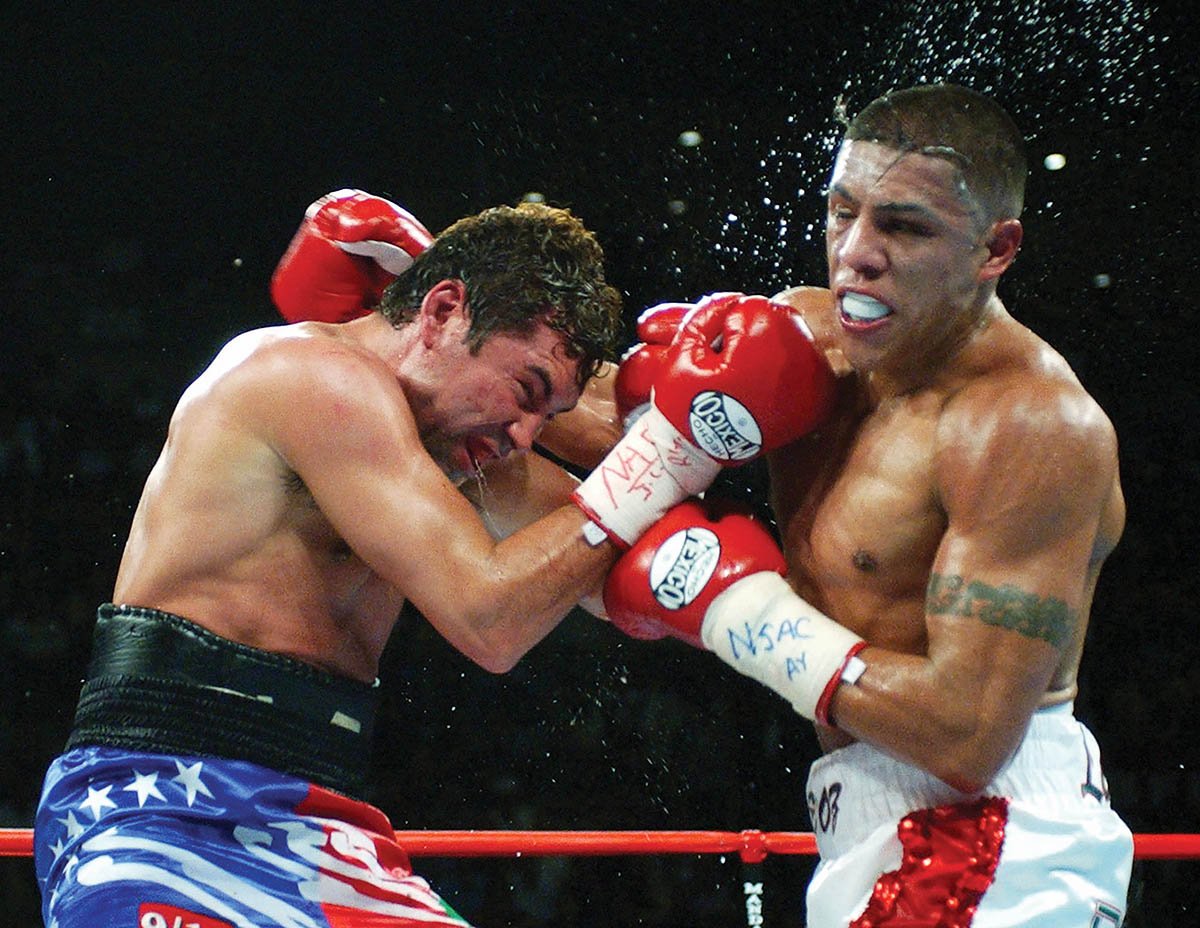
De La Hoya cracks Vargas in their grudge match.
FERNANDO VARGAS
September 14, 2002, Mandalay Bay, Las Vegas • Titles: Ring/WBA/WBC junior middleweight
“The whole ‘Bad Blood’ thing, I strongly believe it was his way to get motivated to hate me. It was his way to pump himself up, because I had no grudge whatsoever against him.
“He was a very tough fighter. He was probably one of the hardest punchers I’ve ever faced. He almost had me knocked out in the first round through the ropes. That’s where I had to show my true heart and really dig down deep inside. It was a classic fight where I was able to knock him out in the 11th round. We find out two weeks later that he had taken anabolic steroids, which obviously answered my question of why he was so strong.
“We’re friends. I always donate money to his foundation. I always try to help him out in any way. He has a fighter, his son Emiliano Vargas, that is amazing, that I want to sign to Golden Boy Promotions.”
Result: De La Hoya TKO 11
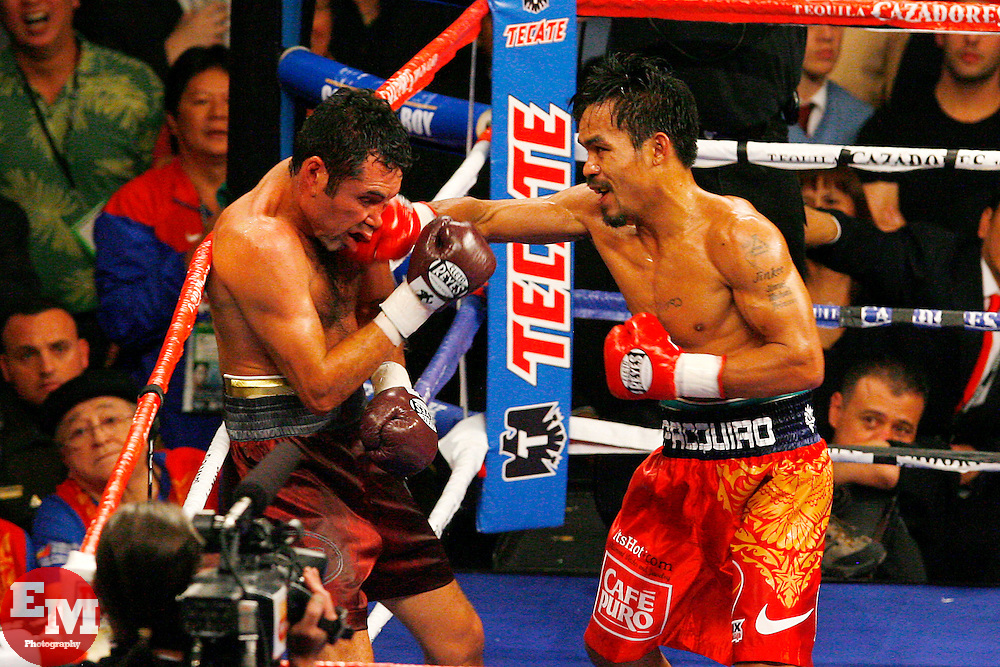
Pacquiao punishes De La Hoya. Photo by Ed Mulholland/HBO Boxing
MANNY PACQUIAO
December 6, 2008, MGM Grand, Las Vegas • Non-title fight
“There’s so many [big fights], but I’m going to go with Pacquiao. The final fight of my career. What people tend to forget, I went up to fight Bernard Hopkins at 160. After the fight, I try to come back down to 147 and fight Pacquiao. Obviously cutting that much weight in boxing is a no-no, but what people don’t know is I weighed [145] for that fight because I had bad nutrition. I had hired a new nutritionist, a new trainer, and everything went wrong. I lost a lot of muscle. Plus my age – I was already older.
“I fought this kid who nobody knew and his name was Manny Pacquiao, and a star was born. He captured the moment. He became the superstar he is today. It was a thrilling career for me and I was able to hang them up, not at the best moment I wanted to, but I knew that was the end. I tried [to fight everybody]. The reason I didn’t fight Vernon Forrest was because he got knocked out by [Ricardo] Mayorga, and I fought Mayorga.” (laughs)
Result: Pacquiao TKO 8















